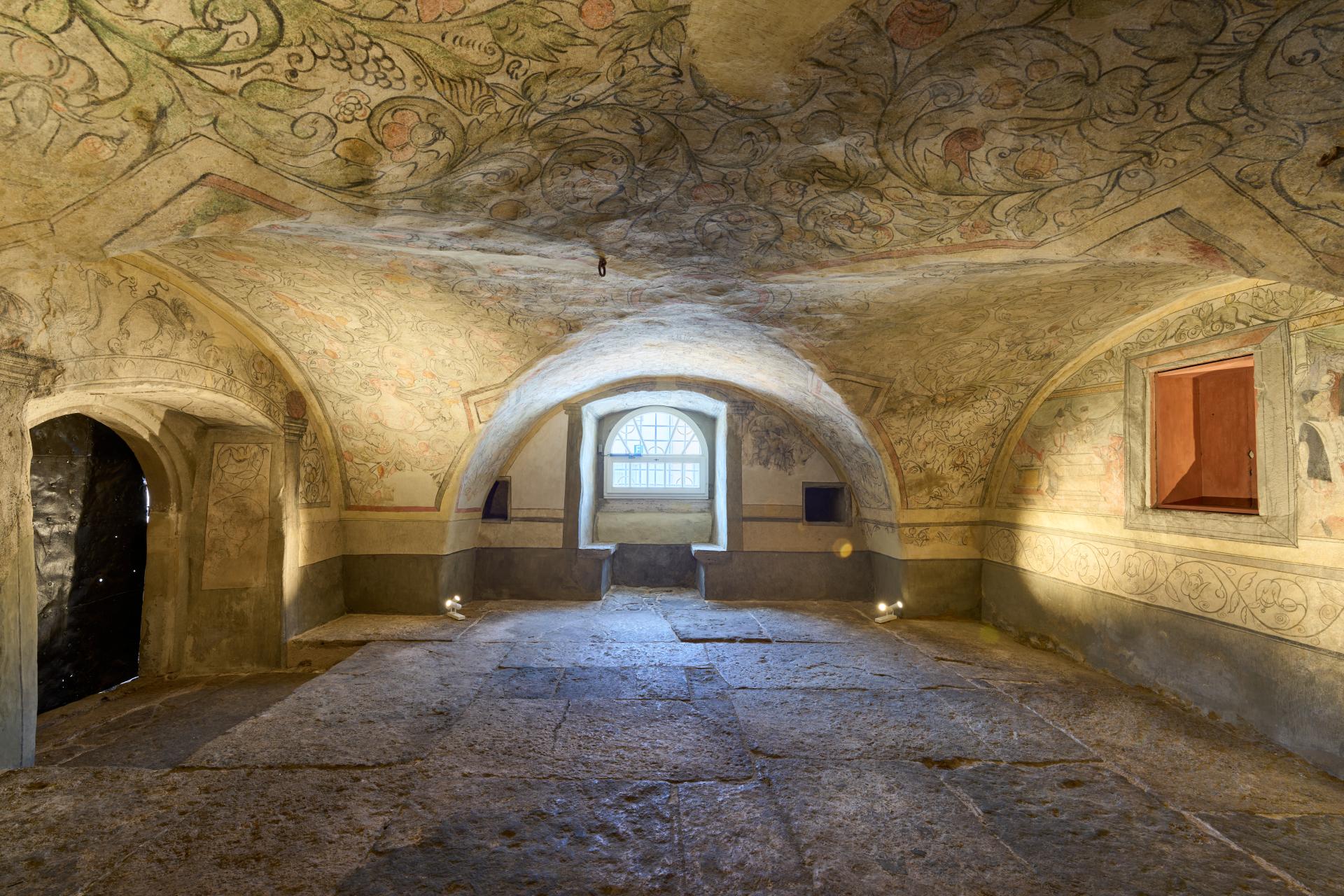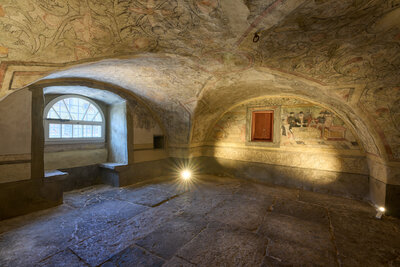Kreuzgratgewölbe
-
Turmfragment mit nachträglich eingezogenem Kreuzgratgewölbe
-
1575 Malereien auf unterschiedlichen Putzgründen
-
1988/89 bei Abrissarbeiten entdeckt
-
2009 - 2014 restauriert
Das Kreuzgratgewölbe am Markt 15 ist ein Turmfragment mit Malereien aus dem 16. Jahrhundert. In den Jahren 1988/1989 befanden sich am heutigen Standort zwei alte Häuser. Eines davon war ein Bauernhaus mit Tenne und Galerie im 1. Obergeschoss. Im Eingangsbereich befanden sich auf der Südseite Wohnstube und Küche und auf der linken Seite Abstell- und Kellerräume. Nach dem Tod der ehemaligen Besitzer sollten die Häuser für neue Wohnungen Platz machen. Die Abrissarbeiten begannen dazu 1988, ohne dass Jemand ahnte, dass sich im vorderen linken Bereich ein wahres Kleinod befand. Nach Beräumung eines Abstellraumes bemerkten die Bauarbeiter, dass sich im Fußboden des Raumes eine Öffnung zu einem Keller befand. Weiterhin bemerkten sie Gemäldefragmente unter abblätterndem Putz und eine auffällige Gewölbedecke. Sie ahnten, dass es sich hier möglicherweise um etwas Besonderes handeln könnte. Baufirma und Bauherr verständigten die zuständigen Stellen und so kam es zum Stopp des Abrisses. Leider war es da für das Bauernhaus schon zu spät. Bei der Untersuchung des Raumes stellte sich heraus, dass es sich um das Fragment eines Turmes mit einem Kreuzgratgewölbe handelte. Nähere Untersuchungen brachten Malereien aus dem 16. Jahrhundert zum Vorschein, die unter mehreren Farbschichten verborgen waren. Das Objekt wurde vom Thüringer Landesamt für Denkmalpflege und Archäologie als stadtgeschichtlich bedeutsames Denkmal eingestuft und die Malerei als einmalig in Thüringen befunden. Das Gebäudefragment selbst besteht aus einem tonnenförmigen Kellergeschoss mit einer Türöffnung an der Nordseite und einem zugemauerten Fenster an der Südseite. Das Erdgeschoss ist fast quadratisch mit einem später eingezogenen, nicht tragenden Kreuzgratgewölbe. Eine Quelle aus dem Jahr 1861 berichtet von einem Klosterhof in Tennstedt, der dem Gothaer Augustinerkloster zugehörig war. Um 1482 sollen dort 20 Mönche gelebt haben. Weiter wird von einem Mietkontrakt berichtet, in dem der Hof 1499 auf lebenslange Zeit an einen Hans Frawen übergeben wird. Dieser erhielt die Auflage, die durchreisenden Mönche weiter zu beherbergen und das Gebäude instand zu halten. Bei der Neubebauung des Grundstückes 1995 wurde das Turmfragment mit viel Aufwand in ein Wohn- und Geschäftshaus integriert. Im Jahr 2009 begann Diplomrestauratorin Suzy Hesse noch während eines Praxissemesters im Studium an der Fachhochschule Erfurt an der Freilegung der übertünchten Malereien. Es stellte sich heraus, dass der gesamte Gewölberaum mit bildlichen und floralen Darstellungen versehen waren. Die Malereien waren auf verschiedenen Putzuntergründen aufgebracht. Das Hauptthema dieser Malerei ist die Darstellung des Zyklus der Königin Esther aus dem Alten Testament. Die vollständige Bemalung des Raumes stammt aus dem Jahr 1575. Dies geht aus zwei Daten hervor, die sich an einer Wand und über der Eingangstür befinden. Frau Bettina Vogel von Frommannshausen beschäftigte sich ebenfalls im Rahmen einer Praktikumsarbeit des Thüringischen Landesamtes für Denkmalpflege und Archäologie mit den Wandgemälden. Die Restaurierungsarbeiten waren im Jahr 2014 abgeschlossen.
-
Tower fragment with subsequently retracted groined vault
-
1575 paintings from
-
1988/89 discovered in demolition works
-
2009 - 2014 restored
The Vault at Market 15 is a tower fragment with paintings from the 16th century. In the years 1988 /1989 there were two old houses at the present location. One of them was a farmhouse with barn and gallery on the 1st floor. Living room and kitchen were in the entrance area on the south side and storage and basement rooms were on the left. After the death of the former owners, the houses should make room for new apartments. The demolition work began in 1988, and no - one suspected that there was `a veritable gem` front left. After clearing a storeroom, the construction workers noticed that there was an opening to a cellar in the floor of the room. Furthermore, they noticed painting fragments under peeling plaster and a conspicuous vaulted ceiling. They guessed that this could possibly be something special. Construction company and client notified the competent authorities and so a stop of the demolition was enacted. Unfortunately, it was already too late for the farmhouse. The investigation of the room revealed that it was a fragment of a tower with a groin vault. Closer investigations brought to light paintings from the 16th century, which were hidden under several layers of paint. The object was classified by the Thuringian State Office for the Preservation of Monuments and Archaeology as a significant historical monument and the painting was considered unique in Thuringia. The building itself consists of a barrel-shaped basement with a door opening on the north side and a bricked-up window on the south side. The ground floor is almost square with a later retracted, non-supporting groined vault. A source from 1861 tells of a monastery in Tennstedt, which belonged to the Augustinian monastery of Gotha. Around 1482 20 monks supposedly lived there. Besides, it is reported in a rental contract that the estate will be handed over for life to a Hans Frawen in 1499. Order was given to him to continue accommodation of the passing monks and to maintain the building. When the estate was rebuilt in 1995, the tower fragment was integrated into a residential and commercial building with great effort. In 2009, the diploma restorer Suzy Hesse began to reveal the painted-on paintings during a practical semester while studying at the University of Applied Sciences in Erfurt. Pictorial and floral representations have appeared in the entire vaulted room. The paintings were applied on different plaster bases. The main theme of this painting is the depiction of the cycle of Queen Esther from the Old Testament. The complete painting of the room dates back to 1575. This is shown by two data, which are located on a wall and above the front door. Bettina Vogel from Frommannshausen also dealt with the wall paintings as part of an internship work of the Thuringian State Office for the Preservation of Monuments and Archaeology . The restoration work was completed in 2014. The vault can be visited on the `Day of the open monument` as well as on agreed dates. Please make an appointment via our city information in the ‘Haus des Gastes’ in the Kurstraße.








